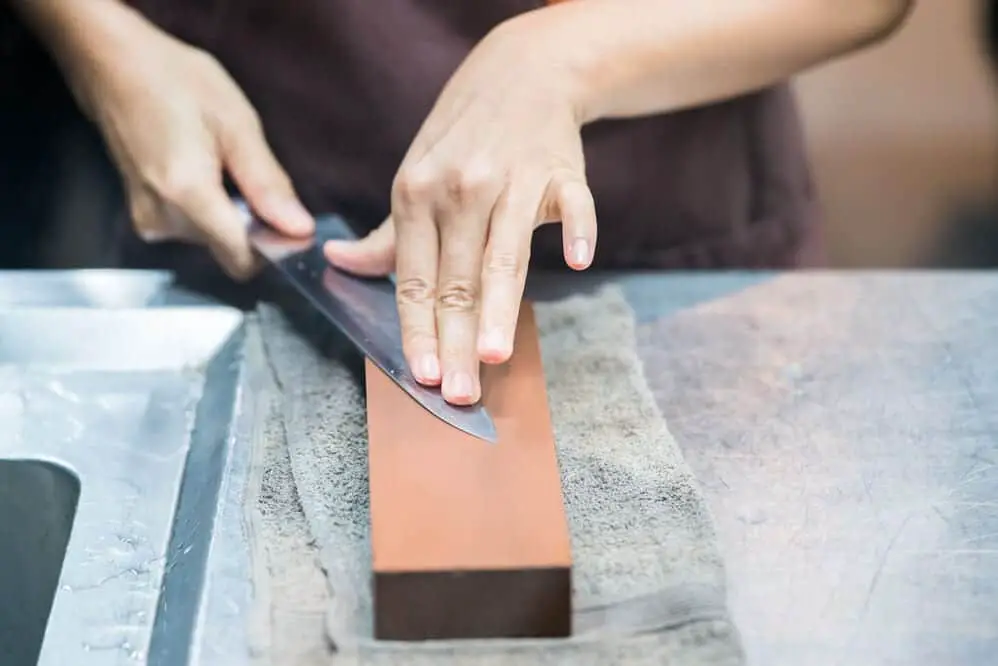If you are into cooking in any way, you will know how important a role your knives play in making sure that your cooking is a fun, and efficient activity. For this purpose, people invest in high-end kitchen knives that cut swiftly and last a long time.
To make sure that they always work well, sharpening your kitchen knives regularly is a necessity. This has been made a very easy process by modern knife sharpeners that are available in most kitchenware stores. However, there are also traditional, but equally effective, solutions which are interesting to consider too.
Methods of Sharpening a Kitchen Knife
Choosing a sharpening method depends on a lot of factors. These include the amount of time you want to put into it, the cost, and the purpose for which you use your kitchen knives. From the several methods available, the oldest but still useful, ones are using whetstones or sharpening steels.
The newer methods involve knife sharpeners, specially designed with grinding wheels, to make the activity very quick and convenient. To make the job even easier, electric sharpeners exist which have your blades back to their best at a flick of a switch. For cooking professionals, sharpening systems and kits are available which come with a variety of tools that can be used to sharpen knives in a fully customizable way.
Using the Traditional Methods
Whetstones and sharpening steels are two different tools that perform the function of sharpening knives in a similarly. Sharpening whetstones are made of abrasive material and are available in different grit sizes. They work really well to thin out the blade and give you a fine finish. Sharpening steels are long cylindrical structures with a handle made of ceramic steel or diamond sharpening steel specifically manufactured to sharpen knives.
To use either of these tools, you need to pull your knife along their length in a uniform manner. Use your non-dominant hand to hold the sharpening tool and your dominant hand to tightly grip the knife.
While holding the tool, vertically and firmly brush the knife’s blade against it. Start with the edge of the blade that is closest to you and pull it down all the way to the end of the tool. This is a very simple process, but you may need to do it a few times to get skilled at it.
Kitchen Knife Sharpeners
Kitchen knife sharpeners are another kind of sharpening tool, and they are widely available. They are similar in length to medium-sized knives and are usually composed of plastic casings and abrasive grinders. Inside the plastic outer body, the grinding wheel, which is available in various grit sizes, is what comes into contact with the blade to sharpen it.
Most knife sharpeners have two grit types, namely coarse and fine. These grit types are used for different functions. The coarse grit modifies the angle of the blade and can be effective if the knife has been used for a long time without being sharpened. The fine one, on the other hand, acts only on the edge of the blade and is used to apply finishing touches.
Using these knife sharpeners is incredibly simple. With the knife sharpener on the table and holding your knife firmly at the handle, pull it through one of the grinding areas towards your body. Do this several times, depending on how much sharpening the knife requires.
Up to 6 motions of the knife through the coarse grit and 3 or 4 more through the fine grit should work well for knives that haven’t been sharpened in the past few months.
If sharpening knives is something you intend to often do, you may prefer to opt for an electric knife sharpener. These use motors to move the grinding wheel so that it rubs against the blade of your knife when you press down on it. The high RPM of the motor enables you to sharpen knives very quickly.

Angle of the Knife While Sharpening
Whichever method you chose, there is an important factor you should be aware of while sharpening a knife. The angle of the blade against the tool is by far the most important determinant of the effectiveness of the sharpening. You already may have noticed that many kitchen knife blades have a curved sharpening edge, which is due to the fact that it makes cutting easier compared with straight edges.
With this in mind, when moving your knife against the tool, you should do so in a way that your action is in accordance with the shape of the blade edge. For instance, your hand should move a little upward and in a curved motion as you pull the knife using the handle. Knowing this tip can help you make your blades razor-sharp using any tool.

